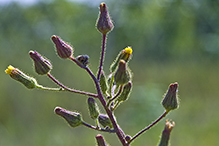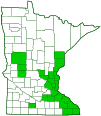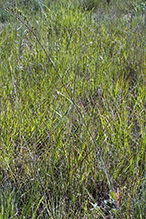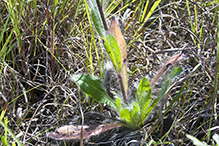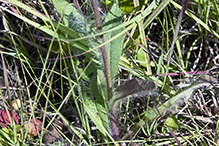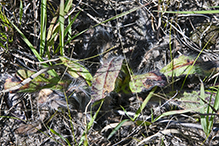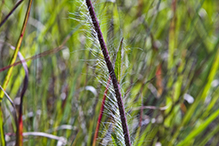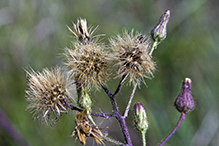long-bearded hawkweed
(Hieracium longipilum)
Conservation • Description • Habitat • Ecology • Use • Distribution • Taxonomy
Conservation Status |
|
|||||||
| IUCN Red List | not listed |
|||||||
| NatureServe | NNR - Unranked SNR - Unranked |
|||||||
| Minnesota | not listed |
|||||||
Description |
||
Long-bearded hawkweed is a 24″ to 6″ tall, erect, perennial forb that rises usually on a solitary stem from a woody, branched, ascending rootstock. The most striking feature of this plant are the long hairs on the stem and leaves. The stems are erect or strongly ascending, stout, finely ridged, and unbranched below the inflorescence. They are hairy with up to three types of hairs. The base of the stem is densely covered with ¼″ to ⅝″ long, white to light orangish-brown, spreading to loosely ascending hairs. These hairs become shorter and sparser as they ascend the stem, the hairs on the upper stem ⅛″ to ⅜″ long. The stems are usually also covered with minute, soft, star-shaped hairs. Finally, the stems are often sparsely covered with gland-tipped hairs toward the top. There are usually 3 to 8 or more basal leaves and 6 to 12 stem leaves. Basal leaves are inversely lance-shaped, short-stalked, unlobed, wedge-shaped at the base, and rounded to sharply pointed at the tip. They can be 1¾″ to 10″ or more long and ½″ to 1 9 ⁄16″ wide, though they are usually no more than 3⅛″ long and 1 3 ⁄16″ wide. They are 4 to 7 or more times as long as wide. The upper and lower surfaces are densely covered with ⅛″ to 5 ⁄16″ long or longer, more or less spreading hairs. The margins are untoothed and have a fringe of long, straight hairs. Basal leaves are often present at flowering time. Stem leaves are similar to basal leaves but are mostly stalkless and are gradually reduced in size as they ascend the stem. The base of the leaf does not clasp the stem. Stem leaves are mostly confined to the lower half of the stem, and are often crowded near the base. If there are leaves on the upper half of the stem, they will be small and bract-like. The inflorescence is a cylinder-shaped, branched cluster (panicle) of 10 to 20 or more flower heads at the end of the stem. Sometimes the inflorescence is unbranched and spike-like. The flower heads are on short stalks that have minute, star-shaped hairs, glandular hairs, and sometimes also long straight hairs. The flower heads are ½″ to ¾″ wide. The whorl of bracts at the base of the flower head (involucre) is bell-shaped and ¼″ to ⅜″ long. The bracts of the involucre are covered with minute, star-shaped hairs and longer, dark-colored, gland-tipped hairs. Each flower head has 30 to 60, though usually no more than 40, yellow ray florets and no disk florets. The fruit is a ⅛″ to 3 ⁄16″ long, urn-shaped achene with 35 to 40 or more straw-colored to orangish-brown bristles attached to the end. |
||
Height |
||
24″ to 60″ |
||
Flower Color |
||
Yellow |
||
Similar Species |
||
The long hairs on the stem and leaves distinguish this plant from all other hawkweeds found in Minnesota. |
||
Habitat |
||
Dry. Prairies, fields, open woods, roadsides. Sandy soils. |
||
Ecology |
||
Flowering |
||
July to August |
||
Pests and Diseases |
||
|
||
Use |
||
|
||
Distribution |
||||
|
Sources |
|||
| 5/7/2023 | ||||
Nativity |
||||
Native |
||||
Occurrence |
||||
|
||||
Taxonomy |
|||
| Kingdom | Plantae (Plants) | ||
| Division | Tracheophyta (Vascular Plants) | ||
| Subdivision | Spermatophytina (Seed Plants) | ||
| Class | Magnoliopsida (Dicots) | ||
Order |
Asterales (Sunflowers, Bellflowers, Fanflowers, and Allies) | ||
Family |
Asteraceae (Sunflowers, Daisies, Asters, and Allies) | ||
| Subfamily | Cichorioideae (chicories, dandelions, and allies) | ||
| Tribe | Cichorieae (lettuce, chicory, dandelion, and salsify) | ||
| Subtribe | Hieraciinae (hawkweeds) | ||
| Genus | Hieracium (hawkweeds) | ||
Subordinate Taxa |
|||
|
|||
Synonyms |
|||
Common Names |
|||
hairy hawkweed long-beard hawkweed long-bearded hawkweed long-haired hawkweed longbeard hawkweed longleaf sagebrush longleaf wormwood prairie hawkweed |
|||
Glossary
Achene
A dry, one-chambered, single-seeded seed capsule, formed from a single carpel, with the seed attached to the membranous outer layer (wall) only by the seed stalk; the wall, formed entirely from the wall of the superior ovary, does not split open at maturity, but relies on decay or predation to release the contents.
Bract
Modified leaf at the base of a flower stalk, flower cluster, or inflorescence.
Clasping
Describing a leaf that wholly or partly surrounds the stem but does not fuse at the base.
Glandular hairs
Hairs spread over aerial vegetation that secrete essential oils. The oils act to protect against herbivores and pathogens or, when on a flower part, attract pollinators. The hairs have a sticky or oily feel.
Involucre
A whorl of bracts beneath or surrounding a flower, flower head, or flower cluster.

Slideshows |
||

Visitor Videos |
|||
Share your video of this plant. |
|||
| This button not working for you? Simply email us at info@MinnesotaSeasons.com. Attach a video, a YouTube link, or a cloud storage link. |
|||
Other Videos |
|||

Visitor Sightings |
|||||
Report a sighting of this plant. |
|||||
| This button not working for you? Simply email us at info@MinnesotaSeasons.com. Be sure to include a location. |
|||||
|
|||||
MinnesotaSeasons.com Sightings |
|||||

|
Created: Last Updated: © MinnesotaSeasons.com. All rights reserved. |
